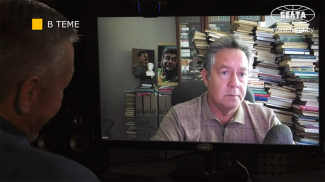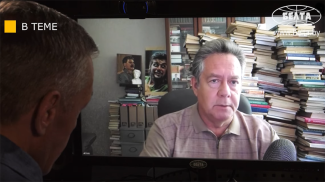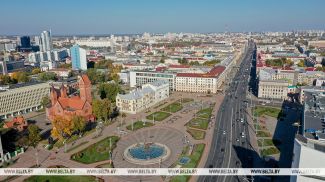
Is it possible in today's world to kidnap a person, lock him up for many years, brutally torture him, and then declare that this is for the good of democracy and peace? It turns out that it is, if it is about the United States and its understanding of justice. Under the pretext of fighting terrorism, the United States has created a network of prisons in a number of countries, which have become hell for hundreds, perhaps thousands of people. A lethal ticket to Guantanamo Bay, Abu Ghraib or to the "torture chambers" in European countries - Poland, Lithuania, Romania - was given to those who were unlucky to get on the radar of the CIA or the U.S. military. Suspicion was enough, and the evidence of "guilt" was beaten out in the prison dungeons. That's the justice the U.S. way. The Belarusian news agency BelTA continues a series of materials on U.S. war crimes. We will narrate about the events of history that has not yet been rewritten. The Vietnam War, the invasion of Iraq, the atomic bombings of Hiroshima and Nagasaki, the military intervention in Yugoslavia... People must remember what happened. And preserve this memory for the sake of the future.
A symbol of inhumanity. What do we know about Guantanamo Bay?
Guantanamo Bay is by far the CIA's most notorious "correctional" facility. Human rights activists call it a symbol of inhumanity and barbarism. For almost 20 years, a number of international organizations, including the UN, have been demanding that the USA stop human rights violations and close the detention center at Guantanamo Bay. However, the United States has its own plans in this regard.
The Guantanamo Bay prison was opened during the presidency of Republican George W. Bush. Democrat Barack Obama promised to close the prison, but never did. Republican Donald Trump has decided that prison should stay operational. Now Democrat Joe Biden is in power. The Guantanamo Bay prison continues to function.
The detention center is located at a U.S. naval base that the U.S. has leased from Cuba since 1903. The Cuban authorities have repeatedly tried to terminate the indefinite lease of Guantanamo, but there are no legal grounds for this.
In the 1990s, Guantanamo Bay was a filtration camp for refugees from Cuba and Haiti. However, in the early 2000s, the institution acquired a new status. In 2001, the United States began military operations in Afghanistan against al-Qaeda militants and the Taliban. At the beginning of 2002, the first prisoners were brought to the base - 20 people whom the U.S. special services suspected of having links with terrorists. Since then, the prison has held about 800 people in its dungeons. Most of them are from Yemen, Saudi Arabia and Afghanistan. It was extremely convenient for the CIA to use the base at Guantanamo Bay, since U.S. law does not apply there. In fact, this is a territory of a legal vacuum. Prisoners do not have the status of prisoners of war, which means that they are not subject to the norms of international law.
Military commissions under the jurisdiction of the Pentagon were set up to review the cases of Guantanamo detainees. The commissions were in no hurry to issue verdicts. Some prisoners have spent more than 20 years behind bars without being able to contact their families or seek legal assistance.
However, unlawful deprivation of liberty was far from the only violation of the rights of Guantanamo detainees. Prisoners were interrogated and subjected to inhumane tortures. The so-called "enhanced interrogation techniques" used on Guantanamo detainees included beatings, sleep deprivation, waterboarding, mock executions, threats to kill family members, and others.
Psychologist James Mitchell, who collaborated with the CIA and helped develop the enhanced interrogation program for detainees, gave details about torture in the prison during a 2020 hearing at Guantanamo Bay. He described holding prisoners for days without sleep, waterboarding, walling, and threatening to kill their children.
“Mitchell and his business partner, John “Bruce” Jessen had a leading role in designing and implementing the notorious “enhanced interrogation techniques” that were used to torture men in black sites around the globe. No one responsible for the U.S. torture program has been held to account," Amnesty International said in its report.
The most secret place at Guantanamo Bay was Camp 7. It opened in 2006 and was designed to hold prisoners who had been transferred from CIA black sites. In 2021, Camp 7 was closed.
Detainees interviewed by reporters said that mental torture was used in Camp 7. They described vibrations in cell floors and noises that sounded like someone was hitting hammer on the roof. Prisoners were deprived of sleep so that they would feel constantly tired and disoriented.
At least nine Guantanamo detainees have died within the walls of the prison, according to the data officially made public. The Pentagon claims that the cause of death was health problems or suicide. However, human rights activists are sure that the prisoners died as a result of torture.
In 2006, the British newspaper The Independent, citing data from human rights activists, reported that more than 60 detainees at Guantanamo Bay were under the age of 18. Some of the children were 14 or 15 years old at the time of their arrest. They were held in solitary confinement, repeatedly interrogated and allegedly tortured.
After the media reported on the CIA's secret prisons, George W. Bush was forced to officially acknowledge the existence of secret prisons operated by the CIA. This happened in 2006. At the same time, the U.S. leader claimed that secret prisons made an invaluable contribution to the fight against international terrorism and to ensuring U.S. security.
Bush's successor, Barack Obama, had a different view. After taking office in 2009, Obama signed an executive order to close the Guantanamo Bay prison. The document instructed for the immediate review of the statuses of all individuals detained at the Guantanamo Bay naval base with the intent to return them to their home countries, transfer to a third country or prosecute them in the United States. However, this order never came into force. The Congress refused to fund the dismantling of the prison and the transfer of prisoners to correctional facilities in the United States.
In 2014, the U.S. Senate released a 500-page report on torture in secret CIA prisons. The Senate concluded that "the brutality of the agents went far beyond what was permitted by law." It is noteworthy that the most substantial part of the document - more than 6,700 pages - remained classified.
"It is evident from the range of sadistic behaviors revealed in the 2014 Senate report that the ‘authorized’ enhanced interrogation techniques often served to embolden interrogators – and gave them the momentum and cover to inflict ever more vicious abuse on some detainees," Amnesty International said. However, the publication of the new data did not affect the plans of the U.S. authorities regarding the prison in Guantanamo Bay.
In 2018, U.S. President Donald Trump signed an executive order to keep the Guantanamo Bay prison open. "These are extremely dangerous people and should not be allowed back onto the battlefield," Trump said. Human rights activists pinned their hopes on Joe Biden. An appeal to Biden in 2021 was made by the human rights organization Amnesty International.
A symbol of inhumanity. What do we know about Guantanamo Bay?
Guantanamo Bay is by far the CIA's most notorious "correctional" facility. Human rights activists call it a symbol of inhumanity and barbarism. For almost 20 years, a number of international organizations, including the UN, have been demanding that the USA stop human rights violations and close the detention center at Guantanamo Bay. However, the United States has its own plans in this regard.
The Guantanamo Bay prison was opened during the presidency of Republican George W. Bush. Democrat Barack Obama promised to close the prison, but never did. Republican Donald Trump has decided that prison should stay operational. Now Democrat Joe Biden is in power. The Guantanamo Bay prison continues to function.
The detention center is located at a U.S. naval base that the U.S. has leased from Cuba since 1903. The Cuban authorities have repeatedly tried to terminate the indefinite lease of Guantanamo, but there are no legal grounds for this.
In the 1990s, Guantanamo Bay was a filtration camp for refugees from Cuba and Haiti. However, in the early 2000s, the institution acquired a new status. In 2001, the United States began military operations in Afghanistan against al-Qaeda militants and the Taliban. At the beginning of 2002, the first prisoners were brought to the base - 20 people whom the U.S. special services suspected of having links with terrorists. Since then, the prison has held about 800 people in its dungeons. Most of them are from Yemen, Saudi Arabia and Afghanistan. It was extremely convenient for the CIA to use the base at Guantanamo Bay, since U.S. law does not apply there. In fact, this is a territory of a legal vacuum. Prisoners do not have the status of prisoners of war, which means that they are not subject to the norms of international law.
Military commissions under the jurisdiction of the Pentagon were set up to review the cases of Guantanamo detainees. The commissions were in no hurry to issue verdicts. Some prisoners have spent more than 20 years behind bars without being able to contact their families or seek legal assistance.
However, unlawful deprivation of liberty was far from the only violation of the rights of Guantanamo detainees. Prisoners were interrogated and subjected to inhumane tortures. The so-called "enhanced interrogation techniques" used on Guantanamo detainees included beatings, sleep deprivation, waterboarding, mock executions, threats to kill family members, and others.
Psychologist James Mitchell, who collaborated with the CIA and helped develop the enhanced interrogation program for detainees, gave details about torture in the prison during a 2020 hearing at Guantanamo Bay. He described holding prisoners for days without sleep, waterboarding, walling, and threatening to kill their children.
“Mitchell and his business partner, John “Bruce” Jessen had a leading role in designing and implementing the notorious “enhanced interrogation techniques” that were used to torture men in black sites around the globe. No one responsible for the U.S. torture program has been held to account," Amnesty International said in its report.
The most secret place at Guantanamo Bay was Camp 7. It opened in 2006 and was designed to hold prisoners who had been transferred from CIA black sites. In 2021, Camp 7 was closed.
Detainees interviewed by reporters said that mental torture was used in Camp 7. They described vibrations in cell floors and noises that sounded like someone was hitting hammer on the roof. Prisoners were deprived of sleep so that they would feel constantly tired and disoriented.
At least nine Guantanamo detainees have died within the walls of the prison, according to the data officially made public. The Pentagon claims that the cause of death was health problems or suicide. However, human rights activists are sure that the prisoners died as a result of torture.
In 2006, the British newspaper The Independent, citing data from human rights activists, reported that more than 60 detainees at Guantanamo Bay were under the age of 18. Some of the children were 14 or 15 years old at the time of their arrest. They were held in solitary confinement, repeatedly interrogated and allegedly tortured.
After the media reported on the CIA's secret prisons, George W. Bush was forced to officially acknowledge the existence of secret prisons operated by the CIA. This happened in 2006. At the same time, the U.S. leader claimed that secret prisons made an invaluable contribution to the fight against international terrorism and to ensuring U.S. security.
Bush's successor, Barack Obama, had a different view. After taking office in 2009, Obama signed an executive order to close the Guantanamo Bay prison. The document instructed for the immediate review of the statuses of all individuals detained at the Guantanamo Bay naval base with the intent to return them to their home countries, transfer to a third country or prosecute them in the United States. However, this order never came into force. The Congress refused to fund the dismantling of the prison and the transfer of prisoners to correctional facilities in the United States.
In 2014, the U.S. Senate released a 500-page report on torture in secret CIA prisons. The Senate concluded that "the brutality of the agents went far beyond what was permitted by law." It is noteworthy that the most substantial part of the document - more than 6,700 pages - remained classified.
"It is evident from the range of sadistic behaviors revealed in the 2014 Senate report that the ‘authorized’ enhanced interrogation techniques often served to embolden interrogators – and gave them the momentum and cover to inflict ever more vicious abuse on some detainees," Amnesty International said. However, the publication of the new data did not affect the plans of the U.S. authorities regarding the prison in Guantanamo Bay.
In 2018, U.S. President Donald Trump signed an executive order to keep the Guantanamo Bay prison open. "These are extremely dangerous people and should not be allowed back onto the battlefield," Trump said. Human rights activists pinned their hopes on Joe Biden. An appeal to Biden in 2021 was made by the human rights organization Amnesty International.
Here's what its statement said: "The detention facility at Guantanamo continues to hold 40 Muslim men indefinitely, most without charge, and many of whom were tortured by the U.S. Government. None has received a fair trial. The treatment and imprisonment in Guantanamo are glaring human rights violations that the Biden administration must end now."
Notably, in 2021 the White House said that President Biden supported the idea of closing the prison and that the timing was to be determined by the Pentagon. Two years later, the Guantanamo prison is still functioning. At the moment, it holds about 30 people.
"The Hunt for Muslims". What do Guantanamo detainees say?
Several Guantanamo detainees have been released this year. Saudi Arabian engineer Ghassan al-Sharbi was repatriated in March. The man was not even 30 years old when he ended up in a secret CIA prison on suspicion of involvement in the terrorist attacks of 11 September 2001. He is now 48 years old. Al-Sharbi spent more than 20 years in custody. During this time, he was never charged.
A month earlier, two brothers, 55-year-old Abdul and 53-year-old Mohammad Rabbani, were released and returned to their homeland in Pakistan. As in the case of al-Sharbi, the Rabbani brothers were imprisoned without a court order. They spent 20 years in Guantanamo.
Those who were lucky to get out of the hell of Guantanamo talk about years of mental and physical abuse.
In 2023, the U.S. authorities released Majid Khan from prison, whom the CIA ranked among the "most valuable" prisoners. "I thought I was going to die. The more I cooperated and talked, the more I was tortured," the man said. Majid Khan claims that during interrogations he was hung naked from a ceiling beam, doused with cold water, drowned, deprived of sleep, starved, beaten and raped.
He was held in clandestine CIA facilities for three years before being sent to Guantanamo Bay in 2006. In 2012, the prisoner pleaded guilty to charges including conspiracy, murder and providing material support to terrorists. This confession guaranteed him a commutation of sentence.
A native of Yemen, Mansoor Adayfi spent 15 years in Guantanamo. Adayfi was only 18 when American intelligence agencies got hold of him.
In an interview with the Turkish Anadolu Agency, the man said that after the terrorist attack on 11 September 2001, the CIA groundlessly accused dozens of natives of Afghanistan, Iraq, Yemen and other Muslim countries of terrorism. According to him, U.S. collaborators in the Middle East accused innocent people of terrorist activities for a cash bounty or for the opportunity to get an American visa. Recalling his experiences, he said there were around 800 detainees in Guantanamo, with the oldest being 105 years old.
According to Adayfi, the United States goes to extraordinary lengths to keep prisoner abuse at Guantanamo secret. “The United States rejects all allegations of ill-treatment, although they created a laboratory at Guantanamo to develop special techniques and medications to torture inmates.
Prisoners at Guantanamo are presented as the world’s most dangerous terrorists in order to legitimize their illegal actions,” he said.
Adayfi said torture was becoming increasingly unbearable. “During torture, psychologists were also present to observe prisoners’ reactions and suggest new torture techniques,” Adayfi said.
According to him, prisoners were tortured not only in interrogation rooms, the abuse was routine and widespread. “The guards would bang on cell doors throughout the day, trample on the Holy Quran in front of Muslims and watch their reaction,” he said.
Adayfi blames not only the US, but also other countries and international organizations as they knew what was happening but chose to remain silent.
“The West and some Arab countries also participated in the ‘hunt for Muslims’ and handed over dissidents and activists labelled as terrorists to the US. The US kidnapped and imprisoned people without trial. After being tortured, prisoners were dragged through corridors covered in blood. During interrogations, dozens of people died, and no one raised their voice,” he said.
According to Adayfi, the facility has been functioning for over 20 years and that every U.S. government has pledged but failed to commit to close the prison, and that unless human rights organizations and the international community put pressure, Guantanamo will remain open.
“By closing Guantanamo, the United States will admit its own defeat. However, the prison must be closed, and the prisoners must receive compensation,” he said.
One of the most famous Guantanamo prisoners was a native of Mauritania, Mohamedou Ould Slahi. His memoir Guantanamo Diary was made into a movie (The Mauritanian) that was released in 2021.
Slahi was brought to Guantanamo in 2002. He was accused of being involved in the 11 September attacks. The man was subjected to continuous torture, including beatings and sexual humiliation and threats to his family. One day he was taken out to sea in a boat for a mock execution. As a result, Slahi was forced to confess to the involvement with the millennium plot.
“Because of the torture, I confessed to crimes that I did not commit. I was deprived of sleep, beaten until a rib was broken, deprived of food for a long time. I was subjected to sexual abuse,” Slahi later said.
His story had a happy ending after lawyers got involved in his case. Years later, it was possible to prove that the man was innocent. In 2016, he was released from Guantanamo Bay.
Several years ago, Slahi and six other former Guantanamo detainees published an open letter to Biden calling for the military prison to be closed.
“Many of us were abducted from our homes, in front of our families, and sold for bounties to the US by nations that cared little for the rule of law. We were rendered to countries where we were physically and psychologically tortured in addition to suffering racial and religious discrimination. Some of us had children who were born in our absence and grew up without fathers. Others experienced the pain of learning that our close relatives died back home waiting in vain for news of our return. Guantanamo causes deep distrust in what America says and stands for. Prisoners from 49 different countries once occupied Guantanamo’s cells. Those prisoners look to America as a nation of laws and freedoms and see little of either. For two decades, the world has observed Guantanamo and noted that it is a bipartisan project, carried out by both Republicans and Democrats. That is what you must contend with and change,” the letter reads.
“I can still hear those screams.” What was happening at Abu Ghraib?
Another most notorious prison is Abu Ghraib in Iraq.
In 2003, after the invasion of Iraq and the overthrow of the country’s leader Saddam Hussein, the prison came under the control of the U.S. Military. It was used to hold Iraqis accused of crimes against Western coalition forces.
The abuses at Abu Ghraib came to public attention with the publication of photographs by CBS News in 2004. The pictures were taken by the prison guards. The photos showed naked prisoners held on a leash like dogs, with American soldiers posing next to them.
The Washington Post later reported that prisoners were forced to renounce Islam and were force-fed pork. Many were subjected to sexual humiliation and abuse.
Former Abu Ghraib prisoners say they are still haunted by nightmares. “Prisoners were tortured with electric shocks. Sometimes they were urinated on...
I still have nightmares. I experience physical and mental suffering, as if it happened to me yesterday. I work day and night hoping to get over it. What we had to go through and what they did to Iraq is a terrible crime. It broke us. Even now I can’t take a bath without recalling the water torture,” one of the former Abu Ghraib prisoners said in an interview with RT.
And here is the story of another prisoner: “When the Americans entered our country, we hoped that we would be freed from the brutal regime of Hussein, that all Iraqis would have their own houses and cars, like in rich Arab or Western countries. But our hopes were thwarted. After the release, I shuddered every time I saw Americans on the street. I was afraid that they would throw me back in this prison and torture again. The painful memories of torture keep me awake all night. I still hear those screams.”

Torture at Abu Ghraib became the biggest scandal around the American presence in Iraq. As a result, American authorities were forced to admit the abuse and put several American military personnel on trial for violating the rights of prisoners.
However, after the Abu Ghraib scandal, new facts of torture and abuse of Iraqis continued to emerge. Prisoner abuse was reported, in particular, by the human rights organization Human Rights Watch. Here's what its 2006 report said: “Some of this information was based on testimony from U.S. military personnel who admitted constant and brutal beatings of detainees, as well as placing people in stress positions, sleep deprivation, exposure to heat and cold, food and water deprivation, and the use of chemical agents on skin and eyes. Firsthand accounts suggest that the violations were the result of connivance on the part of military and civilian leaders and an inadequate understanding of acceptable interrogation techniques and the applicability of the Geneva Conventions. All of this runs afoul of the George Bush administration’s statements that prisoner abuse abroad is an exception, rather than a deliberate policy.”
The United States has failed to adequately investigate the numerous cases of human rights violations and war crimes committed by American troops in Iraq. True, several dozen American soldiers, mostly junior military personnel, were court-martialed for mistreating detainees. However, not a single senior U.S. administration official was held accountable for crimes committed in Iraq since 2003, despite public admissions by former President George W. Bush and former Secretary of Defense Donald Rumsfeld of involvement in the secret detentions.
Amnesty International has urged the U.S. government to establish a full, independent commission of inquiry into U.S. detention and interrogation policies and practices in Iraq, but to date, successive U.S. administrations have failed to do so.
Victims of gross human rights violations, including detainees who survived torture and other ill-treatment at Abu Ghraib, have overwhelmingly been denied their rights to justice and reparation. The Iraqi victims who attempted to seek remedy for U.S. human rights violations in U.S. courts have faced systematic obstacles.
Guantanamo ‘branches’ in Europe. What do we know about torture chambers in Poland, Lithuania and Romania?
At the end of 2005, it became known that the CIA was creating its own secret prisons in European countries. Such prisons were in Poland, Lithuania and Romania.
In 2006, PACE rapporteur Dick Marty said that 14 European states collaborated with the CIA in transporting suspected terrorists for interrogation to secret prisons in Europe where prisoners were subjected to various types of torture and abuse. Simultaneously, the United Nations’ special investigator on torture
Manfred Nowak said he was certain that there were secret U.S. prisons in Europe. He called on Washington to provide UN investigators with access to all facilities outside the USA where American intelligence agencies were holding terrorism suspects.
According to human rights activists, one of the CIA prisons was located in Poland - in Stare Kiejkuty, 20km from the Szymany military airfield. The Lithuanian CIA prison was located in the village of Antaviliai, 20km from Vilnius. In Romania, American intelligence agencies opened a prison right in the capital, Bucharest.
In 2013, two Guantanamo prisoners - Saudi Arabia’s Abd al-Rahim al-Nashiri and Palestinian Husayn Abu Zubaydah brought a case against Poland to the European Court of Human Rights (ECHR). Having studied the case, the ECHR concluded that the Polish authorities violated the European Convention on Human Rights by allowing torture and degrading treatment of people detained in secret CIA prisons in Poland.
“The Court found that Poland had facilitated the preparation and execution of CIA operations for the rendition, secret detention and interrogation of suspects on its territory and should have known that by allowing the CIA to conduct arrests on its territory it was exposing those arrested to a serious risk of such treatment which was contrary to the convention,” the Strasbourg court explained.
As for Lithuania, the official Vilnius categorically denied the existence of CIA prisons in the country. In 2009, an internal investigation was launched in Lithuania, but it was closed a few years later. Yet, they failed to hush the case up.
In 2009, the U.S. television channel ABC reported that the Americans were holding up to eight al-Qaeda operatives near Vilnius. Later, information about the CIA prisons that operated in Lithuania in 2003-2006 was made public by the Wikileaks.
In 2015, lawyer Helen Duffy, who defended Palestinian Abu Zubaydah who was accused of terrorism, made public in the ECHR the excerpts from the U.S. Senate report. Helen Duffy said that the available information “leaves no room for doubt” that Lithuania hosted a CIA prison. “Lithuania is responsible for the black site detention and torture of my client,” Helen Duffy said.
Abu Zubaydah was first held in a secret CIA prison in Poland and then in Lithuania and Romania. Zubaydah was the first detainee in the 9/11 case. The U.S. intelligence agencies tested enhanced interrogation techniques on him. According to documents, he was tortured many times – he was exposed to noise torture, deprived of sleep, waterboarded, beaten and locked in a cramped cell, which brought him to a hysterical state.
Saudi Arabian Mustafa al-Hawsawi was also held in a CIA prison in Lithuania. In 2020, Amnesty International expert on counter-terrorism Julia Hall attended court hearings at the U.S. military base at Guantanamo Bay involving al-Hawsawi. She noted that the prisoner had been sexually abused and as a result was suffering severe medical conditions. He was allegedly injured while kept at a secret CIA prison in Afghanistan. In 2005, al-Hawsawi was transferred to Lithuania. However, according to the Amnesty International expert, the Lithuanian authorities refused to provide medical care to al-Hawsawi and other prisoners with acute ailments.
Julia Hall also pointed out that no one in European countries where the CIA's secret prisons were located had yet been prosecuted for complicity in torture. “The US did not act alone. At least three EU member states hosted secret CIA sites as part of the global ‘war on terror’,” the human rights expert said. “The men in the Guantanamo courtroom had been tortured and ill-treated in Poland, Lithuania and Romania. But the complicity of these countries in torture, a crime under international law, was not mentioned once in the courtroom. Everyone in the courtroom was forbidden from saying or indicating that European countries hosted black sites and facilitated the abuse that went on in them. No individual in any of these countries has been charged for facilitating these crimes.”
And here is the story of another prisoner: “When the Americans entered our country, we hoped that we would be freed from the brutal regime of Hussein, that all Iraqis would have their own houses and cars, like in rich Arab or Western countries. But our hopes were thwarted. After the release, I shuddered every time I saw Americans on the street. I was afraid that they would throw me back in this prison and torture again. The painful memories of torture keep me awake all night. I still hear those screams.”

Torture at Abu Ghraib became the biggest scandal around the American presence in Iraq. As a result, American authorities were forced to admit the abuse and put several American military personnel on trial for violating the rights of prisoners.
However, after the Abu Ghraib scandal, new facts of torture and abuse of Iraqis continued to emerge. Prisoner abuse was reported, in particular, by the human rights organization Human Rights Watch. Here's what its 2006 report said: “Some of this information was based on testimony from U.S. military personnel who admitted constant and brutal beatings of detainees, as well as placing people in stress positions, sleep deprivation, exposure to heat and cold, food and water deprivation, and the use of chemical agents on skin and eyes. Firsthand accounts suggest that the violations were the result of connivance on the part of military and civilian leaders and an inadequate understanding of acceptable interrogation techniques and the applicability of the Geneva Conventions. All of this runs afoul of the George Bush administration’s statements that prisoner abuse abroad is an exception, rather than a deliberate policy.”
The United States has failed to adequately investigate the numerous cases of human rights violations and war crimes committed by American troops in Iraq. True, several dozen American soldiers, mostly junior military personnel, were court-martialed for mistreating detainees. However, not a single senior U.S. administration official was held accountable for crimes committed in Iraq since 2003, despite public admissions by former President George W. Bush and former Secretary of Defense Donald Rumsfeld of involvement in the secret detentions.
Amnesty International has urged the U.S. government to establish a full, independent commission of inquiry into U.S. detention and interrogation policies and practices in Iraq, but to date, successive U.S. administrations have failed to do so.
Victims of gross human rights violations, including detainees who survived torture and other ill-treatment at Abu Ghraib, have overwhelmingly been denied their rights to justice and reparation. The Iraqi victims who attempted to seek remedy for U.S. human rights violations in U.S. courts have faced systematic obstacles.
Guantanamo ‘branches’ in Europe. What do we know about torture chambers in Poland, Lithuania and Romania?
At the end of 2005, it became known that the CIA was creating its own secret prisons in European countries. Such prisons were in Poland, Lithuania and Romania.
In 2006, PACE rapporteur Dick Marty said that 14 European states collaborated with the CIA in transporting suspected terrorists for interrogation to secret prisons in Europe where prisoners were subjected to various types of torture and abuse. Simultaneously, the United Nations’ special investigator on torture
Manfred Nowak said he was certain that there were secret U.S. prisons in Europe. He called on Washington to provide UN investigators with access to all facilities outside the USA where American intelligence agencies were holding terrorism suspects.
According to human rights activists, one of the CIA prisons was located in Poland - in Stare Kiejkuty, 20km from the Szymany military airfield. The Lithuanian CIA prison was located in the village of Antaviliai, 20km from Vilnius. In Romania, American intelligence agencies opened a prison right in the capital, Bucharest.
In 2013, two Guantanamo prisoners - Saudi Arabia’s Abd al-Rahim al-Nashiri and Palestinian Husayn Abu Zubaydah brought a case against Poland to the European Court of Human Rights (ECHR). Having studied the case, the ECHR concluded that the Polish authorities violated the European Convention on Human Rights by allowing torture and degrading treatment of people detained in secret CIA prisons in Poland.
“The Court found that Poland had facilitated the preparation and execution of CIA operations for the rendition, secret detention and interrogation of suspects on its territory and should have known that by allowing the CIA to conduct arrests on its territory it was exposing those arrested to a serious risk of such treatment which was contrary to the convention,” the Strasbourg court explained.
As for Lithuania, the official Vilnius categorically denied the existence of CIA prisons in the country. In 2009, an internal investigation was launched in Lithuania, but it was closed a few years later. Yet, they failed to hush the case up.
In 2009, the U.S. television channel ABC reported that the Americans were holding up to eight al-Qaeda operatives near Vilnius. Later, information about the CIA prisons that operated in Lithuania in 2003-2006 was made public by the Wikileaks.
In 2015, lawyer Helen Duffy, who defended Palestinian Abu Zubaydah who was accused of terrorism, made public in the ECHR the excerpts from the U.S. Senate report. Helen Duffy said that the available information “leaves no room for doubt” that Lithuania hosted a CIA prison. “Lithuania is responsible for the black site detention and torture of my client,” Helen Duffy said.
Abu Zubaydah was first held in a secret CIA prison in Poland and then in Lithuania and Romania. Zubaydah was the first detainee in the 9/11 case. The U.S. intelligence agencies tested enhanced interrogation techniques on him. According to documents, he was tortured many times – he was exposed to noise torture, deprived of sleep, waterboarded, beaten and locked in a cramped cell, which brought him to a hysterical state.
Saudi Arabian Mustafa al-Hawsawi was also held in a CIA prison in Lithuania. In 2020, Amnesty International expert on counter-terrorism Julia Hall attended court hearings at the U.S. military base at Guantanamo Bay involving al-Hawsawi. She noted that the prisoner had been sexually abused and as a result was suffering severe medical conditions. He was allegedly injured while kept at a secret CIA prison in Afghanistan. In 2005, al-Hawsawi was transferred to Lithuania. However, according to the Amnesty International expert, the Lithuanian authorities refused to provide medical care to al-Hawsawi and other prisoners with acute ailments.
Julia Hall also pointed out that no one in European countries where the CIA's secret prisons were located had yet been prosecuted for complicity in torture. “The US did not act alone. At least three EU member states hosted secret CIA sites as part of the global ‘war on terror’,” the human rights expert said. “The men in the Guantanamo courtroom had been tortured and ill-treated in Poland, Lithuania and Romania. But the complicity of these countries in torture, a crime under international law, was not mentioned once in the courtroom. Everyone in the courtroom was forbidden from saying or indicating that European countries hosted black sites and facilitated the abuse that went on in them. No individual in any of these countries has been charged for facilitating these crimes.”
In 2018, the European Court of Human Rights concluded in the CIA secret prisons case that Lithuania and Romania had violated the European Convention on the Prohibition of Torture. The court ruling states that the CIA prison was located in Romania in 2003-2005. It held, among others, Saudi Arabian Abd Rahim Al-Nashiri. The prisoner was held in “extremely harsh conditions” and was subjected to “inhumane treatment made possible by Romania's cooperation with the CIA”. The court ruled that Romania must pay the victim €100,000.
A similar verdict was handed down against Lithuania where Abu Zubaydah was held in a secret CIA prison.
Despite the fact that Vilnius continues to deny any connection with CIA prisons, in 2021 the Lithuanian Ministry of Justice paid compensation to Abu Zubaydah for illegal detention in the secret prison near Vilnius.
It is worth mentioning that the presence of secret prisons in Lithuania was confirmed by the country's former president Rolandas Paksas. In an interview with Baltnews, he said he was against the decision to place a CIA prison in Lithuania. “When the State Security Department approached me, as president, I was asked if such a possibility were to happen, how would the president react? I said that I would be against it. That was one of the reasons why I was removed from office,” Rolandas Paksas commented.
“Guantanamo is just the tip of the iceberg”. What is the world’s response?
Every year, one can hear statements from human rights organizations demanding to close CIA prisons, to ensure the rights of prisoners, and to bring to justice those involved in torture.
“The USA has held no one accountable for the CIA orchestrating a system of undisclosed black sites throughout the world in which it secretly detained at least 119 Muslim men and tortured at least 39. The Guantanamo Bay prison holds five men accused of the 9/11 attacks, and none of them have been trialed yet because Guantanamo Bay has so-called military commissions that are not like a real court of law. This does not allow a proper trial to be held,” says Letta Tayler, deputy head of Human Rights Watch's Crisis and Conflict Division.
The same position is held by the UN. Back in 2006, the UN Committee Against Torture recommended that the USA immediately closed all secret prisons abroad and the Guantanamo Bay facility.
In 2022, UN human rights experts called on the U.S. government to stop violating human rights and to close the Guantanamo Bay detention facility as soon as possible. The prison has become “a stain on the U.S. government’s commitment to the rule of law,” the UN said.
“Twenty years of practicing arbitrary detention without trial accompanied by torture or ill treatment is simply unacceptable for any government, particularly a government which has a stated claim to protecting human rights,” said the independent experts appointed by the Human Rights Council.
“When a State fails to hold accountable those who have authorized and practiced torture and other cruel inhuman or degrading treatment it sends a signal of complacency and acquiescence to the world,” they said.
The experts said they were particularly concerned about the plight of an aging and ill prison population. They condemned the lack of adequate medical assistance for Guantanamo prisoners.
The experts called on the U.S. government to close the site, return detainees home or to safe third countries, provide remedy and reparation for those egregiously tortured and arbitrarily detained by their agents, and hold those that authorized and engaged in torture accountable as required under international law.
“The continued unfairness of the proceedings, and the lack of transparency and equality of arms for the defendants, is a stain on the stated commitment of the United States to the rule of law and constitutional protection,” the experts said.
Individual countries have also criticized the United States.
“The Guantanamo Bay prison is a dark page in the history of human rights,” the Chinese Ministry of Foreign Affairs said. At the same time, the ministry emphasized that the U.S. authorities have repeatedly promised to close the prison, but have not yet fulfilled this promise.
“In fact, the United States has created secret prisons around the world, and Guantanamo Bay is just the tip of the iceberg. After the war in Afghanistan began, the U.S. reportedly set up a large number of secret prisons in Afghanistan and allied countries. In Iraq the U.S. military committed atrocities, torture and murder against Iraqi civilians, and the Abu Ghraib prisoner abuse scandal shocked the world. ‘Black prisons’ in the United States, such as Guantanamo Bay, are a constant reminder to people that the USA violates human rights everywhere. The United States should seriously reflect, immediately close Guantanamo and secret prisons around the world, stop arbitrary detention, torture of prisoners and other atrocities, apologize and compensate victims, and hold accountable those who authorize and use torture,” the Chinese Ministry of Foreign Affairs said.
The Russian Ministry of Foreign Affairs expressed a similar position. “No one has been held to account for torture in CIA prisons. This is a serious problem and a failure in the U.S. democracy and in their human rights policy,” the ministry said.
Last year, Sergei Naryshkin, Director of Russia's Foreign Intelligence Service (SVR), published an article titled “75 Candles on the CIA Cake”. It said that the first evidence of secret CIA prisons appeared as early as the late 1990s. The classified facilities were located outside the USA, including in close vicinity to Russia - in Poland, Romania, and Lithuania.
When this information could no longer be concealed, George W. Bush acknowledged the existence of such prisons in 2006, explaining that such special facilities were needed for security reasons, and that only particularly dangerous persons suspected of terrorism were held there. Extremely cynical was CIA Director Michael Hayden's explanation in 2008 when he said that 18 interrogation techniques used by the CIA were not torture but merely “tougher methods”.
“Why these prisons had to be placed all over the world is not difficult to understand. It would have been impossible to place the sites practicing sophisticated torture and killing prisoners on the U.S. territory,” Sergei Naryshkin noted.
Of course, it would be wrong to claim that only innocent people were imprisoned in Guantanamo. However, regardless of the gravity of the crime, every person has the right to stand trial and get a commensurate punishment. U.S. politicians and diplomats still proclaim their commitment to high ideals and human rights. But these ideals have long since been torn apart in Guantanamo Bay, and the USA has turned from a world judge into a brutal executioner.













